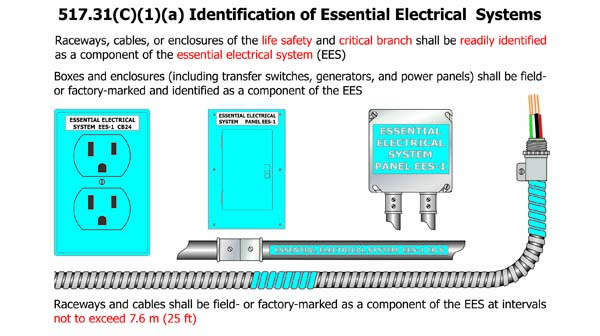517.31(C)(1)(a) Raceways, Cables, and Enclosures of the Life Safety and Critical Branch
Change Summary
- Raceways, cables, and enclosures of the life safety and critical branch of the essential electrical systems of a health care facility are now clearly required be “readily identified” as a component of the essential electrical system. Boxes and enclosures (including transfer switches, generators, and power panels) are to be “field- or factory-marked and identified” as a component of the essential electrical system. Raceways and cables are required to be field- or factory-marked as a component of the essential electrical system. These identifying markings are to be installed at intervals not to exceed 7.6 m (25 ft).
| NEC® Text |
|---|
|
517.31 Requirements for Essential Electrical System. Material taken from the National Electric Code® is reprinted with permission from NFPA 70®, 2020 edition. |
Expert Analysis
The life safety branch and critical branch of the essential electrical system of a health care facility are required to be kept independent of all other wiring and equipment. The “Critical Branch” is defined as “a system of feeders and branch circuits supplying power for task illumination, fixed equipment, select receptacles, and select power circuits serving areas and functions related to patient care that are automatically connected to alternate power sources by one or more transfer switches during interruption of the normal power source.” The “Life Safety Branch” is defined as “a system of feeders and branch circuits supplying power for lighting, receptacles, and equipment essential for life safety that is automatically connected to alternate power sources by one or more transfer switches during interruption of the normal power source.”

The life safety branch and critical branch are two of the three separate branches that make up a Type 1 essential electrical system of a health care facility. Type 1 essential electrical systems are comprised of three separate branches capable of supplying a limited amount of lighting and power service that is considered essential for life safety and effective facility operation during the time the normal electrical service is interrupted for any reason. These three separate branches are the life safety, critical, and equipment branches.
There are two types of essential electrical systems. These two types are a “Type 1 essential electrical system” and “Type 2 essential electrical system.” These two different types of essential electrical systems are based on the level of risk associated with a potential power failure. A Type 1 essential electrical system is the most restrictive and is required for Category 1 patient care spaces. The specific rules pertaining to a Type 1 or Type 2 essential electrical systems are covered in NFPA 99 (Health Care Facilities Code) (see NFPA 99, 6.7.5 and 6.7.6). Type 1 systems are required for Category 1 (critical care) spaces. Type 1 systems are permitted to serve Category 2 (general care), Category 3 (basic care), and Category 4 (support) spaces.
For the 2020 NEC new Code language was added at 517.31(C)(1)(a) that clearly states that raceways, cables, or enclosures of the life safety and critical branch of the essential electrical systems of a health care facility is required be “readily identified” as a component of the essential electrical system (EES). In addition to the raceways, cables, or enclosures, this requirement goes on to demand that boxes and enclosures (including transfer switches, generators, and power panels) be “field- or factory-marked and identified” as a component of the essential electrical system. Raceways and cables are required to be field- or factory-marked as a component of the essential electrical system. These identifying markings are to be installed at intervals not to exceed 7.6 m (25 ft). This added identification marking requirement correlates 517.31 with the identification requirements for emergency systems in 700.10.







